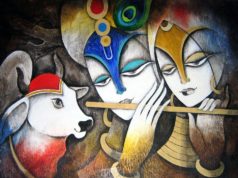The root of peace is the right relation between humans and God, between person and person, between families, between communities, between nations. God is truth and love. Peace is built on the foundations of truth, love and justice. Athiest often brush away denying the existence of a super power called God. They have a notion that if God was there, why would people suffer. It is a belief but Life is a bundle of joys and sorrows and these are the experiences, the trials that we encounter to make ourselves ‘Better People’ and that’s the time when we have to keep the faith. Then, there is peace within and when there is peace, there is love and that itself is the Truth!
Shiva literally means “auspiciousness, welfare”. He is the third god of the Hindu Triad and is the destroyer of all evil. He represents darkness (tamas), and is said to be the ‘angry god’. However, according to Hinduism, creation follows destruction. Therefore Shiva is also regarded as a reproductive power, who restores what has been dissolved. As one who restores, he is represented as the linga, a symbol of regeneration. He has a 1,008 names, including Mahadeva (the great god), Mahesh, Rudra, Neelkantha (the blue-throated one), and Ishwar (the supreme god). He is also called Mahayogi, or the great ascetic, who symbolises the highest form of austere penance and abstract meditation, which results in salvation Shiva is believed to exist in many forms. His most common depiction is as a dark-skinned ascetic with a blue throat. Usually seated cross-legged on a tiger skin, Shivahis hair is matted and coiled on his head, adorned with a snake and a crescent moon. Ganga is always depicted flowing out of his topknot. Shiva has four arms and three eyes. A garland of skulls, rudraksha beads, or a snake hang from his neck. Shiva also wears snakes as armlets and bracelets. The serpent race, despised and feared by all other creatures, found a place of honour on Shiva’s sacred person, simply because he was moved by their plight. In one hand, Shiva holds his trishul, the Pinaka. The trishul usually has a damaru or waisted drum tied to it. In another hand, he holds a conch shell, and in the third, a rudraksha rosary, a club, or a bow. One hand is usually empty, raised in a gesture of blessing and protection. The other points to his feet, where the devotee is assured of salvation. He wears a tiger or leopard skin around his waist, and his upper body is usually bare, but smeared with ashes, as befits an ascetic. His third eye is believed to have appeared when Parvati, in a playful mood, covered his eyes with her hands. Immediately, the universe was plunged into darkness and there w?s chaos. To restore order, Shiva formed another eye on his forehead, from which emerged fire to restore light. The light from this eye is believed to be very powerful, and therefore destructive. Shiva opens his third eye only in anger, and the offender is burnt to cinders. According to the Shiva Purana, Shiva is said to have five faces, corresponding to his five tasks, the panchakriya: creation, establishment, destruction, oblivion, and grace. His five faces are associated with the creation of the sacred syllable Om.
Shiva resides on Mt. Kailash on Himalayas.His vehicle is Nandi and his weapon is Trishul. Parvati is said to be Shiva’s wife and his two sons are known as Kartikeya and Ganesh. Shiva is worshipped in form of Shivlinga or as an idol. Flowers are offered to him and Bel leaves, milk, and sandalwood paste are also pleasing to him. There are many stories in the Puranas about the origin of Shiva. According to the Vishnu Purana, at the beginning, Brahma wanted a child and meditated for one. Presently, a child appeared on his lap and started crying. When asked by Brahma why he was crying, the child replied that it was because he did not have a name. Brahma then named him Rudra, meaning “howler”. However the child cried seven more times and was given seven more names. Shiva therefore has eight forms: Rudra, Sharva, Bhava, Ugra, Bhima, Pashupati, Ishana, and Mahadeva, which, according to the Shiva Purana, correspond to the earth, water, fire, wind, sky, a yogi called Kshetragya, the sun, and the moon respectively. During the samudra manthan, when Shiva poison was churned out of the ocean, Shiva is said to have swallowed it to save the world from destruction. As he drank the poison, Parvati clasped his throat tightly so that the poison remained there and darkened his neck. Because of this, he is known as Neelkantha, the blue-necked one. Shiva granted a peculiar boon to a demon called Bhasmasura, who wished that if he placed his hand on anyone’s head, that person would turn to ashes. No sooner was his wish granted than he menaced Shiva himself, who took to his heels and was saved by Vishnu, in the form of Mohini, the enchantress Induced by Mohini to join her dance, the demon soon killed himself by placing his hand his own head. Shiva and Mohini combined their energies and produced Hari-hara putra (Vishnu-Shiva’s son). It is also said that once, Brahma and Vishnu were discussing who was the supreme god and then when they came to know from Veda that Shiva is the supreme being, Brahma ignored and spoke bad about Shiva. He got angry and cut off Brahma’s head that spoke ill of him, leaving Brahma with four heads instead of five.Shiva is the creator of Dance and of the first 16 rythemic syllabus ever uttered, the Sanskrit language was born. Dance of anger is known as Tandav Nritya, joy as Ananda nritya. Thus, Shiva is also known as Natraja, lord of dance and it is said that on 13th day of each bright lunar fortnight of Hindu calendar, after 6 in the evening, falls a sacred hour called Pradosha and if you worship this time than one gets powers of Universe. It is believed that all Gods gather to witness the dance of Natraja, Shiva.There are around 30 million Linga in temples in India, famous one formed of Ice at Amarnath, Somnath in Gujarat and it is said Shiva sleeps in all Lingas in Chaturmasya and so if one worships the Shivlinga this time, than it is very auspicious. Going for Pilgrimage to all 12 Jyotirlinga means one washes away the sins of last seven births and also reciting the mantras purifies the soul and can attain peacefulness.
BEL TREE in SACRED TREES
Also known as bilva or wood apple (Aegle marmelos), the bel is a medium-sized deciduous tree. It has thorny branches and trifoliate leaves. Its fruit is large and round with a greenish-grey, woody shell. The bel has medicinal properties. Its leaves make poultice for the eyes and are good for diabetes, and the roots help reduce fever. Its fruit is a remedy for dysentery. It is also believed to promote fertility. Its leaves are an important offering to Shiva, for their trifoliate shape signifies Shiva’s three eyes. Since they have a cooling effect, they are offered to the Shivalinga to soothe this hot-tempered deity. Even a fallen bel is never used as firewood, for fear of arousing Shiva’s wrath. Its wood is used only in sacrificial fires. According to the Agni Purana, on any auspicious day in Bhadra, Shiva should be worshipped with a day-long fast and the eating of bel leaves at night. Bel Tree Purana say that Shiva once hid in the bel to escape conquering demons . The Skanda Purana holds that the bel grew from Parvati’s perspiration, which fell to the ground while she performed penance. It also says that the various incarnations of Parvati reside in each part of the tree. The Brihaddharma Purana relates how Lakshmi prayed to Shiva every day and offered him 10,000 lotus buds. One day she fell short by two buds. Remembering that Vishnu had compared her breasts to lotus buds, she decided to offer them instead. She cut one off and offered it humbly. Before she could cut the other, Shiva, pleased with her devotion, stopped her. Her cut breast became the fruit of the bel. The Bhavishya Purana says that after the samudra manthan, Lakshmi, who had just emerged from the ocean, rested in the bel. It was the ninth bright day of Bhadra. Therefore, the bel is worshipped every year on that day.
MORE TREES








